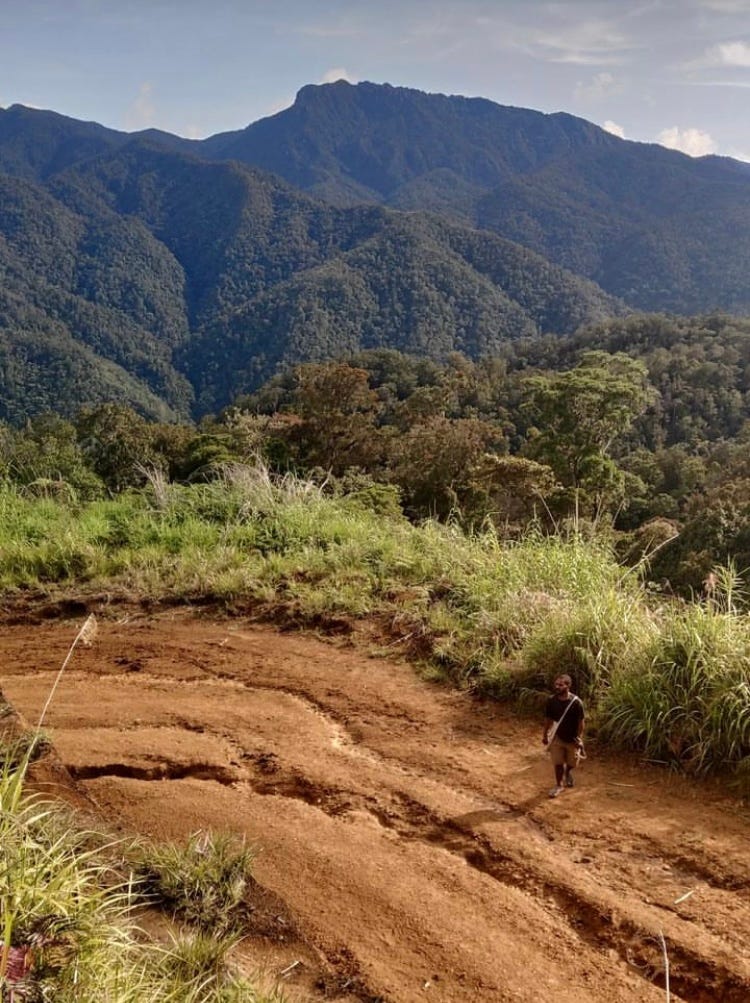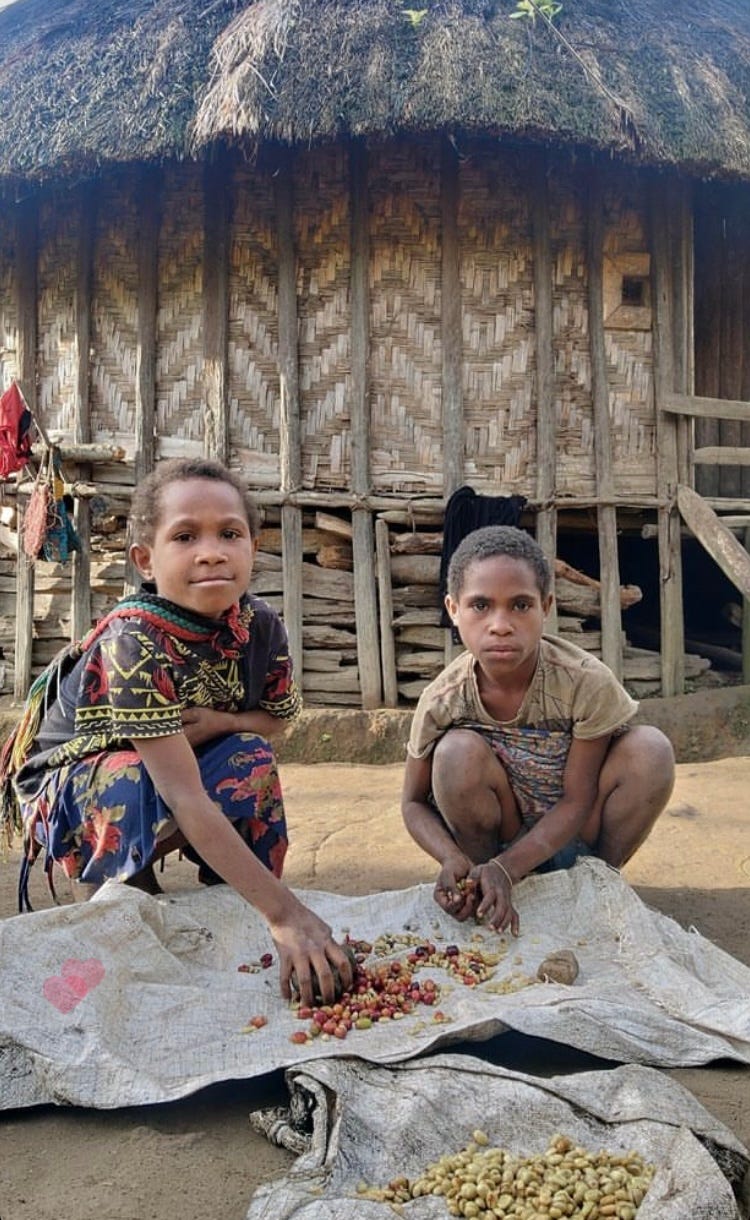Its a little after four am in the morning, theres a rustle of movement in the kunai hut, as a slender woman figure rises from the bed, pauses and rubs her eyes, a soft chant of a prayer follows. She gets up puts on a cardigan crosses the wooden pandanus floor of her home, and exits the house. She returns to the door where a big bilum lies. In this bilum is a bag of dried parchment coffee beans she motions me to to help lift the bilum to place on her hear head as she kneels facing the outside. I willingly abide, the bilum is heavy, about 30kg of dried parchment coffee beans, as she makes her way down the three step ladder and patiently waits for me to gather my stuff and follow her with a piece of baked sweet potato in my hand I follow her.
Awundi, starts on the way: a small woman with a huge bilum bulking on her back, its handle on her head which is padded with an old face towel. One of her hands holding the handle and the other hand wading into the cool morning air. The day slowly moving into light as we set to the two day perilous trek to Menyama in Morobe Province .
Before her is the backdrop of the rugged mountain range of an altitude of 3550 m, she must conquer at 80degree angle in the next couple of hours. By midday, we trek along the meandering dirt road on the spine of this range, for the next two days, the road filled with stories and occasional threats of bandits holding up people like Awundi on their way to sell their family’s dried coffee beans too. Menyama was the only place for miles around where the price though not so good of K3/ kilogram (0.75 US$), compared to other places is better and the road is much more walkable.
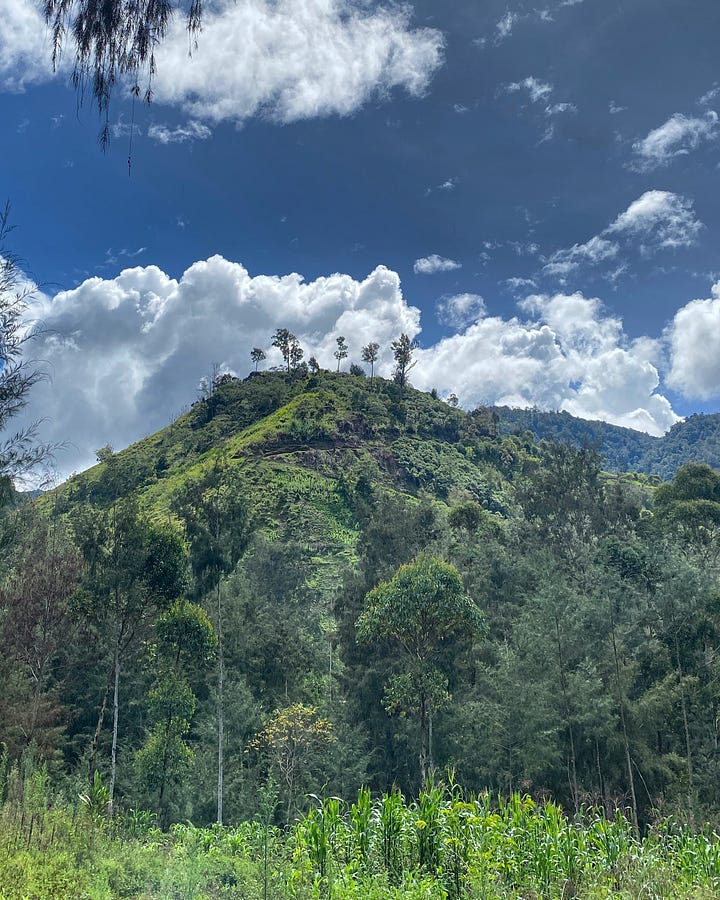
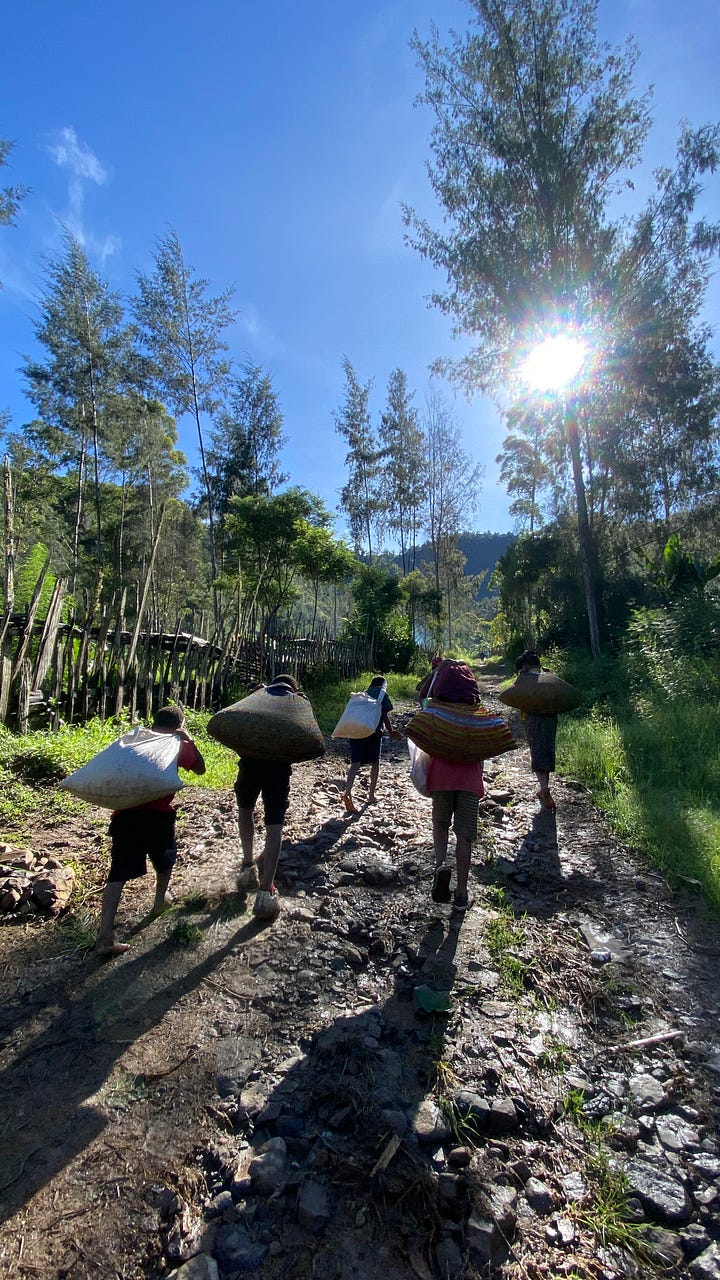
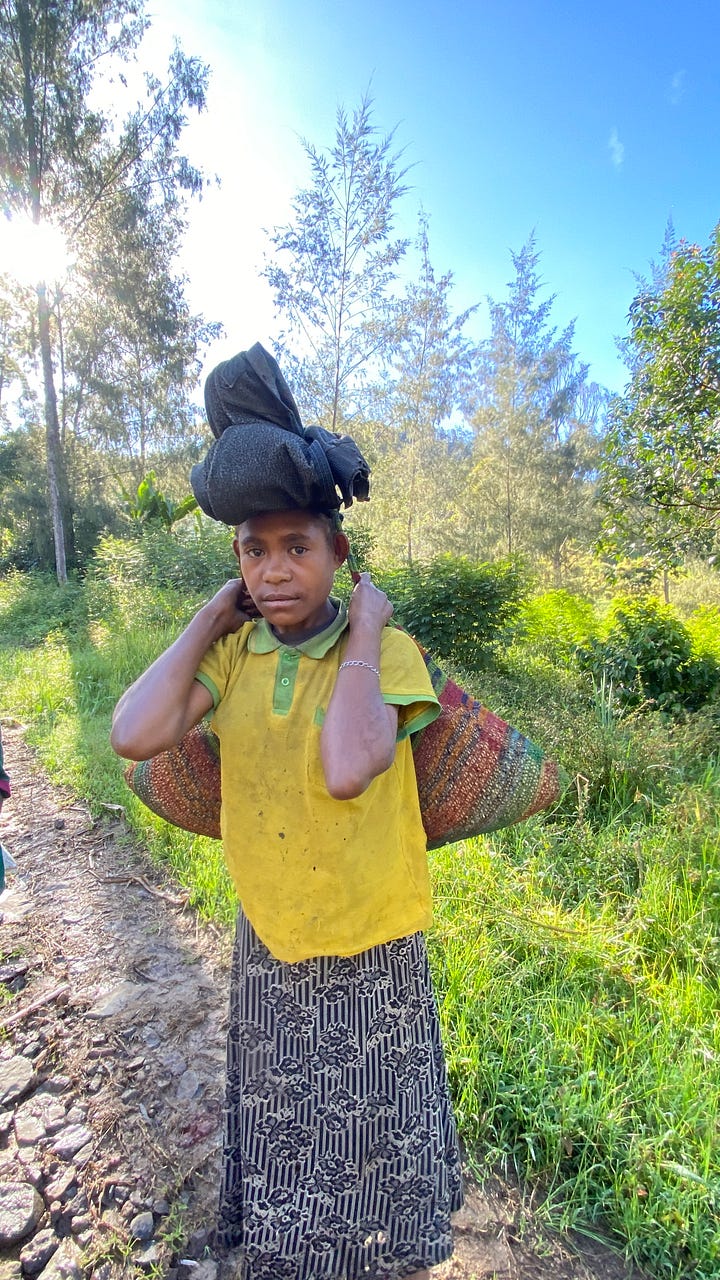
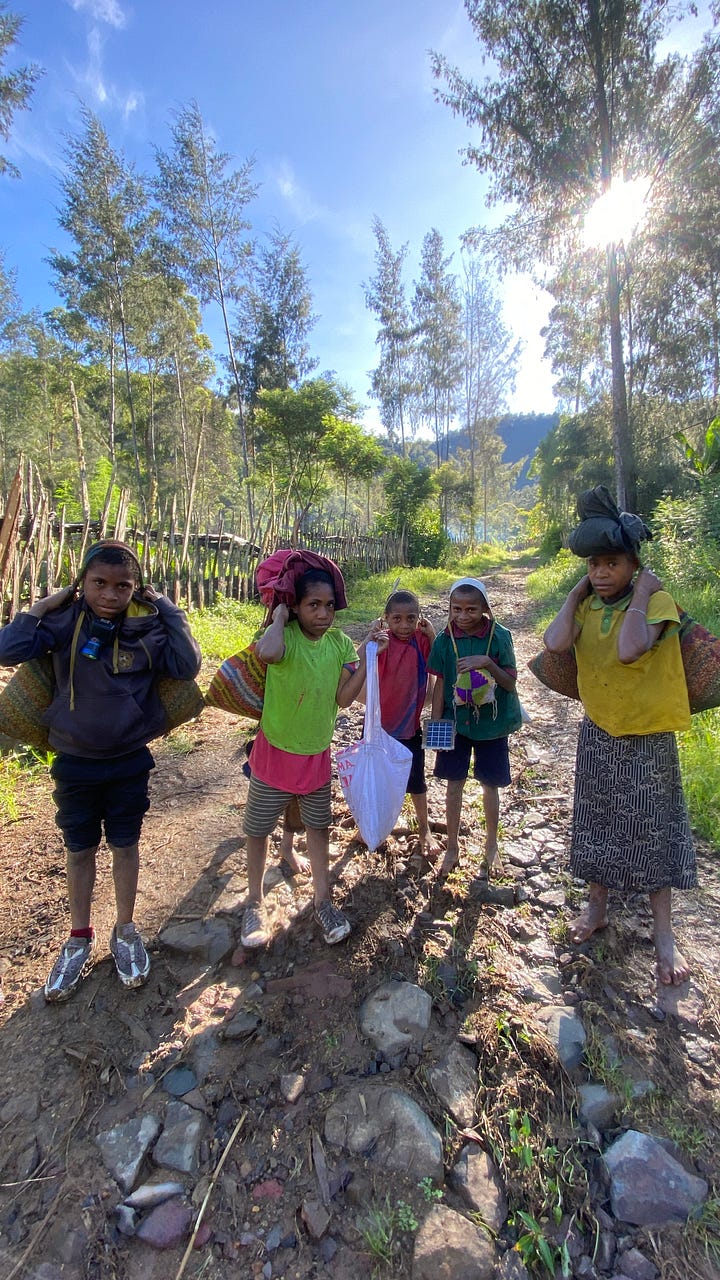
Upon arrival in Menyama, she sold her coffee and generously offered me a K20 to buy my phone credits and coke, of which i declined. Although its highlands tradition to offer people around one at the time, a token of the spoils of good fortune ones experienced. But How could i? Seeing all the noble effort Awundi did in carrying the bilum of coffee for nearly 2 days and not for once complained.
This is one of the millions of journey women, men and children who live along the commodity belt take to sell their commodities. This story happened in 2020.
When it comes to the production of commodities like cocoa, coffee, and vanilla, we often don't consider the true cost of these products. While we enjoy the luxury of savoring a delicious cup of coffee or indulging in a chocolate bar, we rarely think about the impact these products have on the people and communities who produce them.
For many indigenous communities, the production of these commodities have been a double-edged sword - whilst they bring economic incentives and opportunities, they come at a cost.
So what are the hidden costs of commodity supply chains in indigenous communities? and what we can do to support sustainable and equitable practices?
The commodity supply chain typically starts with the sourcing or production of raw materials, which can involve growing or harvesting crops, mining minerals, or extracting oil or other natural resources. (For this purposes of this article i will talk about my area of interest, which is commodities specifically coffee.)
The ripe coffee beans harvested are then processed or refined into a usable form, the process involves: in order of pulping, washing, drying ie refining, or other forms of transformation at the farm level mostly involves manual labour. Most times farmers cant afford labour so they ask their extended family and children to help extract the commodity from its natural state. Most farmers are not skilled labour, rather legacy farmers, that is the farmers carrying on the practical knowledge that their parents showed them, or how their parents interpreted and applied farming techniques.
The majority of the coffee traded in the world are produced by countries lying in the coffee belt or the equator. Most of these countries have indigenous farming communities like in PNG, that are producing these commodities and in unfavorable conditions. The exploitation of indigenous communities in commodity supply chains is a long-standing issue that demands attention.
Most farmers arent empowered enough to make the ideal ethical choices given the opportunity cost weighs in on neccessity versus luxury in the market that favours the socially conscious consumer. For instance, the luxury of using paid labour versus the reality of family labour (most likely involves free labour) In rural communities like Marawaka, farmers can not afford paid labour and so young girls like Zappo and Justina (pictured) have to leave school weeks at a time during coffee season and enter straight into the farm to help with household production of coffee. In a region where 99 percent of people rely on coffee, this is very common and could in part explain the literacy rate here for women which is at 31percent. (But thats just assumption on my part).
Most coffee farmers still live in poverty despite the growing concern for ethical practices in the supply chain, indigenous peoples continue to face exploitation and marginalization in the production of coffee. These practices show up in various ways, such as they (farmers) are often paid low wages in plantations or for their crop, have little or no bargaining power, are subjected to hazardous working conditions and have no access to market, which leaves them vulnerable to low prices offered by the middle man. These practices not only violate human rights but also contribute to the widening gap between the rich and the poor. For instance the value difference between parchment coffee and a cup of coffee is significant when a kilogram of coffee is less than a dollar compared to $5for a cup of coffee(which is essentially 3-6 beans of coffee). At times when i consider the effort farmers give its unfair that families sacrifice so much for the bare minimum and yet what could i as a participant in this supply chain do to help compensate the farmer for their effort?
For me, my company which in essence is a social enterprise, in the golden age of information, it is crucial to create awareness to the market of the various issues the smallholder farmer faces through social media and various other platforms to enlighten the consumer and work towards developing sustainable and equitable supply chains with stakeholders within the industry that prioritize the economic well-being of indigenous communities.
Also this could take on the focus of incentivizing, such as offering better prices when we encourage farmers to produce quality products.
The large-scale commodity production such as plantations in indigenous territories have had a significant social and environmental impact. This was done across the highlands and coastal regions by the deep pockets of Steamships in New Guinea, which eradicated and ignored traditional land ownership. In PNG, most of these plantations faced a myriad of social and economic issues and failed after independence which created problems of land ownership in tribes and even led to triabl fights that lasted for years passing on to generations. This also contributed to the current fragmented plantations and decline in coffee production as disputing factions of locals most times with limited farm management knowledge took over plantations.
In terms of loss of biodiversity many grassland areas were replaced with coffee plantations, hillside coffee farms replaced the rainforest canopies of fern and moss. The use of pesticides, fertilizers, and other chemicals in agriculture contaminated the soil and water, and harmed wildlife and human health. In coffee farming, agro forestry has replaced natural habitats,which is basically the practice of growing trees in coffee garden to provide shade to young coffee saplings.
Additionally, the construction of infrastructure, such as roads, pipelines, and dams, can disrupt ecosystems, fragment habitats, and displace indigenous communities. The impacts of large-scale commodity production on the environment and have disproportionately affected indigenous peoples who depend on natural resources for their livelihoods and cultural traditions. The large plantations use pesticides for weed control and in time affect the quality of soil. As such, there is a growing need for more sustainable and equitable models of resource extraction and land use.
When we support sustainable and equitable practices not just at the farm level but also in commodity supply chains it becomes crucial for the well-being of indigenous communities and the environment. Without these practices, communities may be exploited by powerful buyers and left with few economic opportunities. Furthermore,
Consumers have a significant role to play in creating positive change in the commodity supply chain, particularly in supporting brands that prioritize social and environmental responsibility. By choosing to support these brands, consumers can send a clear message to the industry that they value sustainability, ethical sourcing, and fair labor practices. When consumers purchase products from socially and environmentally responsible brands, they are directly supporting the farmers and producers who are committed to making a positive impact in their communities. Additionally, consumers can educate themselves on the issues facing commodity supply chains and advocate for change through their purchasing decisions. Through conscious consumption, consumers can help create a more just and sustainable world.
Side Note: Also i believe i can say so much on this topic but since ive been experiencing a form of writers block, i thought to publish this to get the ball rolling again with my writing and to save myself from the abyss of never publishing again :-)




